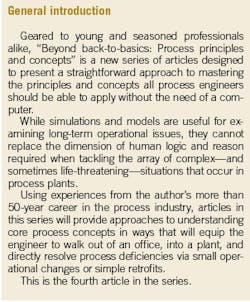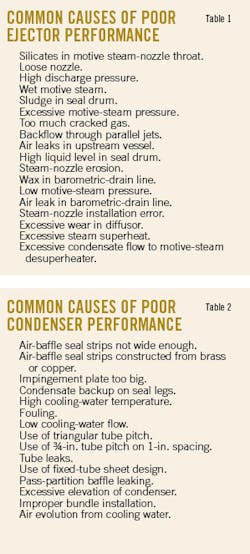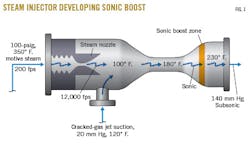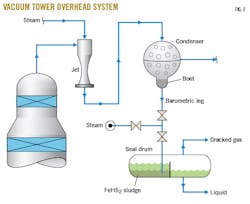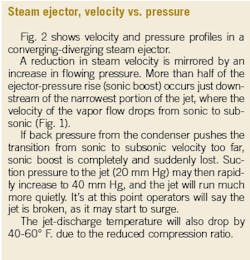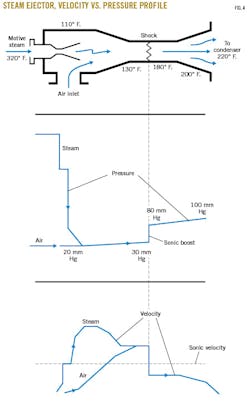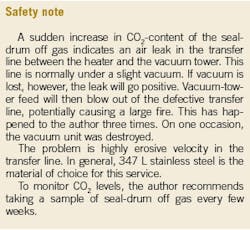Beyond back-to-basics: Process principles and concepts-4: Understanding vacuum system performance problems
Norman P. Lieberman
Process Improvement Engineering
Metairie, La.
A complex piece of equipment, the converging-diverging steam jet used in vacuum distillation units is subject to a wide array of malfunctions that are often misunderstood or overlooked by plant personnel.
Because of their complexity, these systems can require massive amounts of time and money to fix when something goes wrong, particularly when the problem results in a loss of vacuum. Simple conversations, however, combined with a basic understanding of how vacuum systems work can equip unit operators and engineers to find and implement on-site solutions.
Vacuum loss
"Mr. Norm, you have a minute? Linda, my girlfriend, wanted me to tell you it's time we get married."
"That's against departmental policy, Dave. Technical service engineers are prohibited from marrying. It's the rule."
"But Linda says that's your rule, not refinery policy. We've been dating for more than a year, and she says…"
"No," I said. "Is that all, Dave? I'm busy here."
"Geez, Mr. Norm," Dave sighed. "Maybe you could help troubleshoot a problem on the #2 vacuum tower, then?"
"What's the problem?" I asked.
"The flash zone's running at 55 mm mercury (Hg). Our D-1160 ASTM distillation analysis shows the vacuum resid contains a lot of gas oil, like 20%, 1050° F. and lighter. It used to run at 35-40 mm Hg with a gas oil content of 10-12%, 1050° F. and lighter, which means we're losing about 3,000 b/sd of heavy gas oil to vacuum-bottoms resid. At a $20/bbl downgrade to coker feed, we're losing $60,000/day."
"When did this start getting so bad?" I asked.
"It's been gradual, Mr. Norm, over the past year."
"Vacuum systems are complicated, Dave, and they're hard to understand. Let's talk, and then we'll go out to #2 vac to investigate the problem in the field."
Dave agreed, so I began with an overview of possible culprits for the progressive loss of vacuum. The number of potential causes are enough to fill a book, so-based on Dave's description of the issue-I narrowed the list to those most commonly behind vacuum-system upsets: performance issues associated with steam ejectors and condensers.
Table 1 shows, in order of frequency-beginning with the most frequent-common causes of poor ejector performance. Table 2 shows, also in order of frequency, common causes of poor condenser performance.
Motive steam-nozzle malfunctions
"Silicate hardness deposits accumulate at the nozzle throat. This restricts the steam flow and leads to a loss of sonic boost, meaning the jet is forced out of critical flow."
Dave stared at me in confusion.
"What exactly is sonic boost, Mr. Norm? Is that good or bad?"
"It's good, Dave."
To illustrate the concept, I sketched a diagram of sonic boost developing in a vacuum system's steam ejector (Fig. 1).
"You see, the motive steam flows into the steam jet at 100-200 fps and blasts out of the steam nozzle at 10,000-12,000 fps. That's seven or eight times the sonic velocity. At some point in the diverging part of the steam ejector, though, the steam slows to subsonic flow. The vapors catch up to each other, like a sudden traffic jam on the interstate. The kinetic energy of the vapors converts to pressure, which is the sonic boost. While I've seen an ejector's discharge-to-suction-pressure ratio (compression ratio) reach as high as 12:1, a more typical compression ratio is 7:1."
"So the ejector's like a compressor but without moving parts? What's compressing the flow, then, Mr. Norm?"
"The velocity of the steam, Dave. As velocity of the steam slows, its kinetic energy suddenly converts to pressure."
"Okay, but where does the kinetic energy of the steam come from? From the steam's pressure?"
"No, it comes from the heat of the steam.1 If you look at Fig. 1, the steam cools to 100° F. from 350° F. as it flows through the steam nozzle. That's called isentropic expansion."
"We learned about that in my thermodynamics course back at LSU. I earned an A in that class, by the way, Mr. Norm!" Dave said proudly.
Smiling, he glanced down to the sketch, nodding in apparent recognition of the concept. After a moment, though, his expression again seemed perplexed.
"What's going on in there, Dave?" I asked. "All this making sense?"
"It is, but I'm trying to put all the pieces together," he said. "You see, sometimes the steam jet starts making a surging, sickly kind of sound, and suddenly, our vacuum starts getting really bad. The top pressure can jump from 20 mm Hg to 40 mm Hg, and the operators say the jet is breaking. Is this caused by silicates plugging up the steam nozzle's throat?"
"No, Dave, the surging, or hunting, sound means you've lost the sonic boost, meaning the ejector is no longer in its critical mode of operation. Vendors call this the break-and-pick-up mode of operation. Most often it's caused by jet-discharge pressure exceeding its maximum-allowable discharge pressure (MADP) as shown on the ejector's performance curve supplied by the vendor (Fig. 2 and accompanying box). Maybe the problem is a high ejector-discharge pressure because the downstream condenser is fouled. Or, maybe it's the…"
"So it's not just the steam nozzle getting fouled with hardness deposits from the motive steam?" Dave interrupted.
"It's complicated, Dave."
Silicates in steam
"So I guess the silicates in steam are caused by poor-quality boiler-feed water, Mr. Norm?"
"No, Dave, not usually. It's more likely that the boiler suffers from poor level control. Water, full of silicates, carries over into the steam."
"If that's my problem, what can I do?"
"Dave, often there's a clean-out plug on the back of the ejector. You can shut down the jet, remove the plug, and scrub out these deposits."
"Sounds pretty simple," Dave said. "What else?"
"The second most common cause of poor ejector performance is loosening of the steam nozzles. The nozzles are made of 316 stainless steel, but they're screwed into a carbon-steel ejector body. Since our steam is wet, galvanic corrosion results. The carbon-steel threads get eroded, allowing steam to blow out around the nozzle."
"I guess that means we should buy a new ejector, then, huh, Mr. Norm?"
"Certainly not, Dave!" I exclaimed. "You young engineers are always ready to spend money on new equipment when we're still just diagnosing the problem. And if eroded nozzles are the source of our issue, the solution is a lot cheaper! All you need to do is wrap the nozzle threads with Teflon tape, or a Teflon pipe-thread paste, and tightly screw the steam nozzle back into place."
"And that works?" Dave asked incredulously.
"Like a charm," I said. "And at thousands-of-dollars less than replacing the ejector!"
"Noted, Mr. Norm. So what other possible causes am I looking at?"
"Well, Dave, the next most common problem is wet steam. A little bit of moisture is no big deal. If the steam's very wet, though, it can make a big difference.2 If you're seeing white steam blowing out of the bleeder's tip, it's wet. Dry steam is invisible. To fix this, I make sure the desuperheating station is on auto and set for 10-20° F. above saturation temperature; 20° F. of superheat is no big deal. Best to just ignore superheat unless it's more than 50° F., Dave. Just don't do like one refinery did and set the desuperheater for 5° C. below saturation. When I was called out to troubleshoot the issue, I blocked in the condensate flow, improving the vacuum tower-top pressure to about 25 mm Hg from 35 mm Hg. That was a savings of about $50,000/day for the refinery."
"So wet steam's really that bad, Mr. Norm?"
"Well, yes, but I don't know how to quantify the effect. If the steam looks a little white, it's probably okay. If it's blows out of the bleeder dripping wet, that could be a big problem. For example, at an Alabama refinery, I once wrapped 20 ft of 2-in. steam line with rags and gained 3-4 mm Hg tower-top vacuum. Since the refiner was borderline on its paving-asphalt hardness specification, this was a major improvement."
Motive-steam pressure
"Mr. Norm, Linda wants you to come over for dinner tonight."
"Sorry, Dave. It's against refinery policy for management to engage socially with employees' girlfriends. Next question."
"How about steam pressure, then? What's best: higher or lower?"
"Good question, Dave. You'd think higher-pressure steam would help, but my experience teaches that, when exceeding MADP, vacuum improves by reducing the steam pressure. When you do this and it works, your discharge condenser's overloaded. If you reduce the supply-steam pressure by 10%, the condenser load will drop by about 10%, perhaps allowing the jet-discharge pressure to drop below its MADP. I did this at the Alabama refinery and upgraded 9,000 b/sd of vacuum resid from coker feed into paving-grade asphalt, which was worth about $30/bbl to the refiner."
"Whoa, Mr. Norm, that's like $270,000/day! You must've been paid a fortune for that!"
"Sadly, it doesn't work that way," I said.
I shared another story with Dave about my work in a Delaware refinery where I improved vacuum to about 15 mm Hg from 18 mm Hg by increasing the motive-steam pressure to 160 psig from 140 psig. The higher-pressure steam stopped the jet from surging. The refiner had been controlling to the design motive-steam pressure of 160 psig, but the pressure control valve (PRC) was at grade, while the steam jet was about 100-ft high and located the equivalent of several hundred feet of piping away.
"You must've figured that out immediately, Mr. Norm!"
"Nope, Dave. I sat on the sixth landing alone, in the dark and cold, with a nasty, wet wind coming off the Delaware River until midnight before resetting that PRC up to 160 psi. You see, Dave, with vacuum systems, it's not being smart that counts; it's being persistent."
Seal-drum problems
"Dave, there's also a whole class of problems related to the seal drum and barometric-drain legs that cause liquid backup in surface condensers. The liquid covers the tubes and raises the condenser pressure above the MADP."
I drew another diagram to illustrate the issue as it occurs in the vacuum tower's overhead system (Fig. 3).
"One common problem is an air leak in the barometric leg. Air gets sucked into the leg and interferes with condensate drainage from the condenser boot."
"How do you find leaks like that, Mr. Norm?"
"Cold spots, Dave! Air drawn from the atmosphere through a hole into a vacuum cools off as it expands."
"That's Joule-Thomson expansion," Dave correctly interjected. " I guess we'd have to shut down to fix those leaks?"
"Not at all," I said. "Use duct tape, which works especially well for leaking flanges. That said, I once fixed this type of problem at a refinery in Coryton, UK, by wrapping a flange on a steam-turbine exhaust surface condenser with masking tape, which debottlenecked the fluid catalytic cracking unit's air blower. My wife, Liz, was working in this plant at the time, and it's actually where we met."
"Cool, Mr. Norm," Dave said. "You can bring Ms. Liz tonight to dinner at Linda's apartment."
"Liz is too busy," I said. "Anyway, the biggest problem with seal drums is sludge, mainly iron sulfides, Fe(HS)2. This sludge covers up the bottom of the seal leg from the first-stage condenser, preventing it from properly draining."
"It must require a shutdown to clear out sludge, right, Mr. Norm?"
"No, Dave. I'll share a trick I learned from operators at a Wyoming refinery. Just blow out the seal leg with steam to clear away the sludge and restore condensate drainage. You can tell when you need to do this steam-out by looking at the temperature difference between the condenser vapor outlet and the boot. When the boot is 10-20° F. colder than the vapor-outlet nozzle, it's time to blow out the seal leg. The Wyoming operators did this about once a week. You can avoid the problem entirely, however, by either cutting off the seal leg to about 2 ft above the drum's bottom or by cleaning the seal drum during every turnaround."
I shared another example with Dave based on a troubleshooting experience at refinery in Shreveport, La., where the vacuum tower's seal drum had a level-control problem.
"The drum's level was showing it 60% full of hydrocarbon liquids when it was really 100% full. I lowered the level, and the condensate drained out of the condenser. The vacuum tower pressure dropped like a rock sinking into the ocean. The level control had been calibrated for water (1.0 specific gravity, sp gr), but the drum was mostly full of light naphtha (0.6 sp gr)."
Air leaks
"Mr. Norm, I think air leaks anywhere could overload the jets. How can I tell if it's a big air leak, though?"
"Get a bicycle-tire inner tube and squeeze out all the air. Then, reinflate it with gas from the top tap of the seal-drum level glass. Be careful, though! The seal-drum off gas can contain 10-40% H2S, and a concentration of just 1% H2S can kill you! If the gas chromatograph result shows less than 10% N2, forget about air leaks. If it's 20% N2 or higher, you have a problem. If you have 10% O2 with 40% N2, the air leak is likely in the vacuum system itself.3 If there is 10% CO2 and no O2, the air leak is likely in the vacuum-heater transfer line, which is very dangerous. Let me know pronto if you find a high-CO2 concentration in the seal-drum off gas, and I'll report this to the refinery owner immediately." (See safety note).
After reiterating the severity of the issue and securing Dave's promise for compliance with my instructions, we next addressed other potential causes of the #2 vac tower problem.
"Too much cracked gas also can overload the vacuum system. Most of the cracked gas is formed in the vacuum heater tubes. To suppress thermal cracking, increase the heater-pass coil steam by 1 lb/bbl."
"Anywhere else I should be looking for cracked gas, Mr. Norm?"
"Yes, sometimes much of the cracked gas is formed in the vacuum tower's bottom boot.4 To handle this, either lower the tower-bottoms level by 20%, or reduce the boot-quench temperature by 20° F."
"Got it, Mr. Norm."
"But maybe the problem isn't cracked gas, Dave. It may be virgin C3's and C4's that aren't getting stripped out of the vacuum-tower feed. In this case, try raising the crude tower's bottom-stripping steam by 20-30%. I like to use about 0.15 lb of steam per 1 gal of vacuum-tower bottoms."
Boot quench-exchanger leaks
"Last year, Liz and I were in Spain…"
"On vacation, Mr. Norm?"
"No, Dave, and never use the V word in front of Liz! We were working at a refinery, where I found the vacuum tower's boot-quench exchanger was leaking boiler-feed water into the boot-quench return line and overloading the first-stage ejector with water vapor. The ejector's overloading resulted in a loss of vacuum, forcing the tower-top pressure up to 45-50 mm Hg."
Again, I sketched out a diagram of the unit process configuration to help illustrate the scenario for Dave (Fig. 4).
"To remedy the problem, Liz and I opened a bypass line to divert the boiler-feed water, after which the tower-top pressure dropped to 30-35 mm Hg. But then there's a whole bunch of problems associated with surface-condenser internal vapor baffles that, if not correctly adjusted during tube-bundle installation, can…"
"Mr. Norm, stop," Dave interjected. "I can't remember all this, it's too complicated. Can't we just ask an expert to troubleshoot the problem for us? I think our jets were made by Croll-Reynolds or Nash."
"Dave," I said. "I'm as close to an expert as you're going to get. Besides, there's only one thing to understand when troubleshooting vacuum systems, and it goes something like this."
I stood up from my desk, gathered up my tools and, opening the office door, gestured for Dave to follow.
"You have to take your tools, your chemical engineering education, and your determination out to the unit. That's it, Dave. It's all a matter of time and determination."
"Kind of like meeting girls, Mr. Norm?"
"You got the idea, David."
"But that's why I'm determined to marry Linda, Mr. Norm. We've been together for nearly a year now, and it's taken me all that time…"
"Sorry, Dave," I said, interrupting him. "It's the policy of this refinery's technical service department to prevent young engineers from engaging in any distractions from their work, marital or otherwise."
And with that, we headed to the #2 vac tower to apply in the field our discussion of ways we might solve the problem .
References
1. Power, R.B., "Steam Jet Ejectors for the Process Industries," McGraw-Hill, New York, 1994.
2. Lieberman, N.P., "Troubleshooting Vacuum Systems: Steam Turbine Surface Condensers and Refinery Vacuum Towers," 1st ed., John Wiley & Sons, Hoboken, NJ, 2012.
3. Putman, R.E., "Steam Surface Condensers," ASME Press, New York, 2001.
4. Lieberman, N.P., "Troubleshooting Steam Ejectors," Petroleum Technology Quarterly, Vol. 19, No. 5, Fourth Quarter 2014, pp. 125-129.
